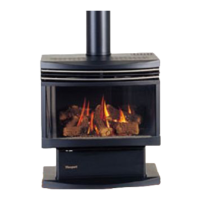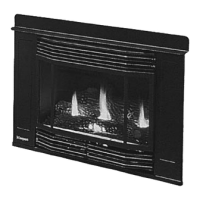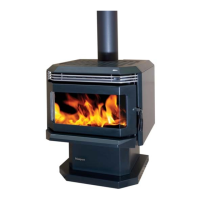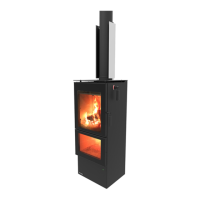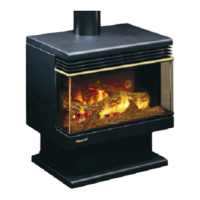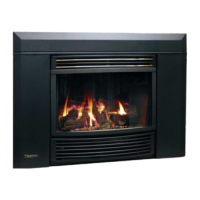Masport PG36-3 Gas Inbuilt
18
Offset Chart
Galvanized pipe is desirable above the roof-
line due to its higher corrosion resistance.
Continue to add pipe sections through the
flashing until the height of the flue cap meets
the minimum height requirements specified in
Diagram 5 or local codes. Note that for steep
roof pitches, the vertical height must be in-
creased. A poor draft, or down drafting can
result from high wind conditions near big trees
or adjoining roof lines, in these cases, increas-
ing the flue height may solve the problem.
7) Ensure flue is vertical and secure the base
of the flashing to the roof with roofing rails,
slide storm collar over the pipe section and
seal with a mastic.
8) Install the vertical termination cap by twist-
locking it.
Note: Any closets or storage spaces,
which the flue passes through
must be enclosed.
Diagram 3
Diagram 5
Diagram 1
Diagram 2
Note: Apply sealant "Mill-Pac" to inner
pipe and high temperature sili-
cone sealant to outer pipe on eve-
ry twist-lock joint.
VERTICAL
TERMINATION
1) Maintain the 1-1/4" (32mm)
clearances (air spaces) to com-
bustibles when passing
through ceilings, walls, roofs,
enclosures, attic rafter, or oth-
er nearby combustible surfac-
es. Do not pack air spaces with
insulation. Check pages 12-14
for the maximum vertical rise of
the flueing system and the max-
imum horizontal offset lim-
itations.
2) Set the gas appliance in
its desired location. Drop
a plumb bob down from
the ceiling to the position
of the appliance flue exit,
and mark the location where the flue will
penetrate the ceiling. Drill a small hole at his
point. Next, drop a plumb bob from the roof
to the hole previously drilled in the ceiling,
and mark the spot where the flue will
penetrate the roof. Determine if ceiling
joists, roof rafters or other
framing will ob-
struct the flue-
ing system.
You may wish
to relocate the
appliance or to
offset, as
shown in Dia-
gram 2 to avoid
cutting load
bearing mem-
bers.
3) A Firestop spacer must be installed in the
floor or ceiling of every level. To install the
Firestop spacer in a flat ceiling or wall, cut
a 10 inch square hole. Frame the hole as
shown in Diagram 3 and install the firestop.
4) Assemble the desired lengths of pipe and
elbows. Ensure that all pipes and elbow
connections are in the fully twist-locked
position and sealed.
5) Cut a hole in the roof centered on the small
drilled hole placed in the roof in Step 2. The
hole should be of sufficient size to meet the
minimum requirements for clearance to com-
bustibles of 1-1/2" (38mm). Slip the flashing
under the shingles (shingles should overlap
half the flashing) as per Diagram 4.
Roof Pitch Minimum Flue Height
Feet Meters
flat to 7/12 2 0.61
over 7/12 to 8/12 2 0.61
over 8/12 to 9/12 2 0.61
over 9/12 to 10/12 2.5 0.76
over 10/12 to 11/12 3.25 0.99
over 11/12 to 12/12 4 1.22
over 12/12 to 14/12 5 1.52
over 14/12 to 16/12 6 1.83
over 16/12 to 18/12 7 2.13
over 18/12 to 20/12 7.5 2.29
over 20/12 to 21/12 8 2.44
Diagram 4: The upper half of the flashing is
installed under the roofing material and not
nailed down until the chimney is installed.
This allows for small adjustments.
6) Continue to assemble pipe lengths.
Note: If an offset is necessary in the attic
to avoid obstructions, it is impor-
tant to support the flue pipe every
3 feet, to avoid excessive stress
on the elbows, and possible sep-
aration. Wall straps are available
for this purpose (Diagram 2).
INSTALLATION

